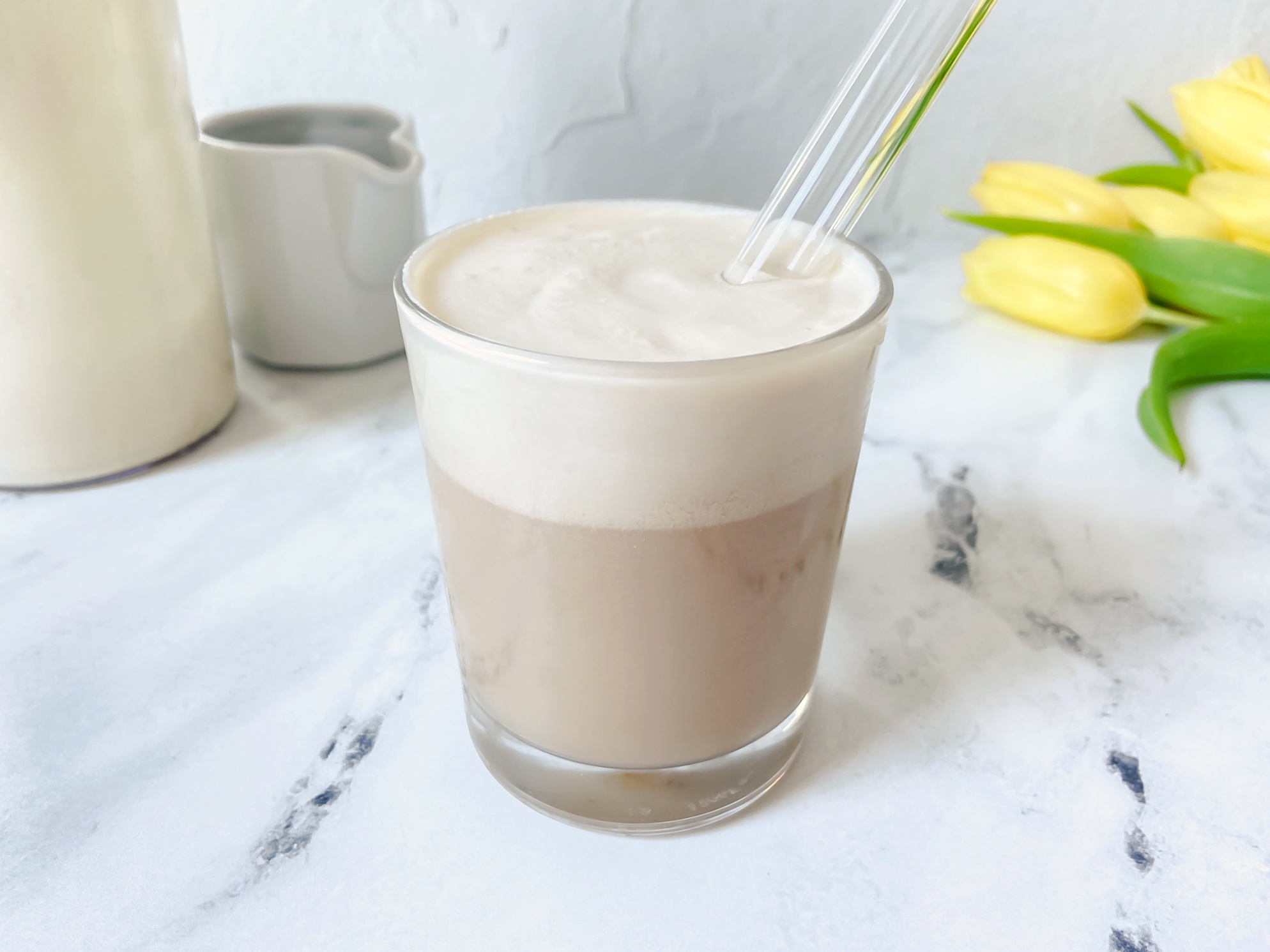Creamy almond milk (that froths)
How to make barista almond milk at home: easy recipe to make almond milk that froths well (with only 2 ingredients)

Almond milk is getting quite popular: it’s a great milk alternative for those who want to avoid dairy and/or those who follow a low-carb diet.
So, nowadays you can find almond milk in almost any supermarket.
However, many of the premade almond milk brands don’t froth so well, so if you’re looking for an inexpensive, all natural almond milk that tastes great and makes a nice foam to make lattes, you have to try this recipe!
[Even if you don’t care about frothing your almond milk, this recipe is still for you: it has truly awesome flavor and smell]
Is it worth making your own almond milk?
Oh, yes!
We (my family and me) don’t follow a vegan diet and I personally love dairy milk, but my husband began buying almond milk for his protein shakes and to save some calories (because I didn’t know it, but almond milk is one of the most low caloric types of milk out there!).
So, as the DIY type I am, I did some research to learn how to make almond milk at home… and I was REALLY surprised at how simple it is!
My parents used to make their own soy milk and I remembered it being very time-consuming, so I assumed making any kind of milk would be similarly time-consuming.
But it’s definitely the opposite: unlike when making milk from legumes, there’s no cooking involved.
In fact, making almond milk from almonds is one of those things that it’s so easy to make that once you know how to do it, you get embarrassed at how long you bought it premade.
So, by now you can find online thousands of recipes on how to make your own almond milk.
But still, I would like to share here how I make mine because most of the recipes I’ve tried taste too watery for me and this recipe makes almond milk that froths wonderfully!
I’ll also let you know my favorite recipes to enjoy almond milk and to use up the almond pulp the remains after making the milk.

This post may contain affiliate links. This means, if you make a purchase through one of these links, I may earn an affiliate commission at no extra cost to you. Here you can read my affiliate disclosure.
Reasons to make homemade almond milk
- It’s cheaper than store-bought: you get milk AND also some almond pulp to make dishes and desserts with it
- It’s convenient: you won’t need to buy heavy containers with milk or store them, but instead only almonds, which take less space in the pantry (and are also much lighter to carry)
- It tastes great: maybe you have a favorite brand of almond milk and you like it better than homemade, but I haven’t tried any store-bought than tastes and smells better than mine, specially when fresh blended.
- You know what’s in: it contains no additives nor additional sugars (unless you want it to)
Common questions about homemade almond milk
Yes, almond milk is keto-friendly. It’s low in carbohydrates and high in healthy fats, making it a great choice for a low-carb diet.
A cup (8oz.) of almond milk is said to contain around 40 kcal (17 kcal per 100 ml), so it’s one of the lowest calorie milk.
Yes, unsweetened almond milk is high in vitamin E (which is a fat-soluble antioxidant) and low in sugar, so it’s considered a healthy drink.
However, people with a tree nut allergy and small children under 1 year should avoid it.
Also, almond milk is rich in oxalate, which people with a history of kidney stones are advised to reduce.
Almond milk is (unless enriched) very low in calcium and proteins.
And it’s unsuitable for people with nut allergy, small children under 1 year and (probably) people with a history of kidney stones.
Homemade almond milk stored in the fridge with a tight lid will last up to 3 to 5 days (but the fresher, the better tastes it).
If it smells different as when fresh made, it gets a sour taste or a thicker texture, you should discharge it.
You may make kefir using almond milk: the milk will ferment when you add kefir grains to it.
But (and it’s a big BUT for me) since almond milk is low in proteins and fat, the resulting kefir won’t have the thick and creamy texture one expect from kefir. It gets very runny instead, so I personally don’t like it to make kefir (my favorite milk to make vegan kefir is soy milk).
Yes, warm almond milk tastes good too.
However, it’s important to avoid almond milk from boiling, because it scorches easily and when burnt, it can taste different and bitter.
That’s why the best way to heat almond milk is over medium heat, keeping an eye on it, or using the microwave for 30 seconds (and then add 30 seconds more if it hasn’t reached your desired temperature).
Milk froths best when it has fat and proteins. Almond milk lack both, so it’s usually tricky to foam it.
However, making this recipe the original ratio of almonds (1 cup almonds for 2 cups of water) makes a rich almond milk that froths very easily.
How to make creamy almond milk
This is what you’ll need to make almond milk:
Just 2 ingredients
- Almonds
Use raw almonds.
No need to use blanched almonds, which are those ones that look white because they have the brown skin removed.
You may also use roasted almonds as long as they don’t have salt and/oil added.
- Water
Regular water (tap water) is enough.
Optional ingredients
If you want to make flavored almond milk, you may add a pinch of salt, cinnamon, some sweetener or a few drops of vanilla extract.
Equipment
- A blender
Any type should work as long as it’s powerful enough to blend nuts and liquids together.
Before I got my high speed blender, I made my almond milk with a regular hand mixer.
Now that I also have a strong blender, I use it because it’s slightly quicker, but both options work great.
- A nut milk bag, a cheesecloth or any other type of fine mesh strainer
If you don’t have one, you can use a regular sieve to get rid of the almond pulp, although this will take longer and eventually your milk won’t be as smooth.
But that isn’t so bad if you plan to use the almond pulp in recipes like cakes, thick smoothies or for eating porridge or granola.
Time needed: 8 hours
How to make almond milk at home
- Soak the almonds
Plan ahead* to soak the almonds overnight (or for at least 6-8 hours) in room temperature water.
This helps them to soften enough so they can be blended easily and also get rid of any bitter taste they may have.
*If you are in a rush, you can also soak them for 1-2 hours in hot water.
- Discharge soaking water
Drain the water off and rinse the almonds with water.

- Blend
Blend the almonds with FRESH water (not the soaking water) for around 1 minute or until the almonds are pulverized.

- Drain
Drain by placing the nut bag on a container and pouring the blended almond milk inside.
Then gently press the bag with your hands to get the most of the milk out.
- Enjoy right away or store.
Transfer to an airtight container and store it in the fridge for up to 3-5 days. Shake before use.
Feel free to froth it if desired.
You can save the almond pulp from the nut bag or cheesecloth after straining and use it to make almond flour or add it to smoothies, muffins and other recipes.
How many almonds to make almond milk?
It’s very easy to adapt this recipe so you get the amount of almond milk that you’ll like to have: usually, you get roughly as much milk as added water.
Regarding the ratio almonds to water:
I use 1 cup of raw almonds per 2 cups of water, because I like my almond milk creamy.
In fact, we (at home) call this our homemade barista almond milk or homemade almond creamer.
However, many recipes use more water, up to 4 cups of water per 1 cup of almonds, so if you want your almond milk to be lighter, feel free to add more water.
My recommendation is to begin with 2 cups of water and eventually add more after tasting it: you can always add more water, even after straining (and it’s easier so).
Just remember that if you would like to froth this almond milk, it’s best to leave it with the original proportions.
Personally I prefer preparing smaller batches so the almond milk is freshly made: it tastes better!
So, I usually only make around 20 oz. (500 ml) of almond milk (using 1 cup or 100 gr. of almonds and 2 cups or 500 ml of water).
But if you need more, I’ve made a cheat sheet to make it easier for you to know how many almonds and water you’ll approximately* need depending on how much almond milk you want:
| Amount of almond milk | Almonds needed* | Water for blending |
|---|---|---|
| A cup (236 ml.) | Half cup of almonds | 1 cup |
| 500 ml. | 100 gr. (1 cup) | 500 ml. |
| A quart (4 cups) | 2 cups | a quart |
| A litre | 200 gr. | 1 liter |
| A gallon (16 cups) | 8 cups | a gallon |
*Remember that this makes for rich almond milk; if this “barista” almond milk tastes too concentrated for your taste, just add more water, up to doubling the amount of liquid.
Also, this is based on my results, but it could vary depending on the type/brand of almonds or tools you’re using.
Tricks
How to make almond milk quickly
If you forgot to put your almonds to soak, don’t worry.
You can make almond milk without soaking the almonds overnight by soaking them in fresh boiled water for 1-2 hours.

Then discharge this water, add fresh one and blend just as described in the recipe.
How to flavor almond milk
If you want to give your homemade plant-based milk a natural flavor, you may add a vanilla extract or cinnamon or blend in a couple of dates to the milk.
I find it easier to add flavor after draining the milk.
Frothing homemade almond milk
The only “secret” to make almond milk that froths is to use enough almonds.
Then, you just need to do the same you would do to froth regular milk:
- warm it until it’s around 150 °F (65 °C)
- froth following your preferred method (with a handheld frother, in a steamer or with a French press)
It took 20 seconds with a French press from Ikea to get this foam:

A handheld frother (the kind that’s battery driven) also work, but when using it to froth plant-based milk, it always gets me bigger bubbles (less fine) as a French press.
Recipes that use almond milk
You may use your homemade almond milk to replace cow’s milk in almost any recipe.
In some recipes, you might notice a difference in the taste, but if you like your almond milk, you won’t probably bother.
Personally I don’t enjoy adding any kind of plant-based milk to add it to tea, but that’s a personal taste thing.
However, I find that most of smoothies and shakes that use dairy milk also use great with almond milk.
These are some recipes that go very well with almond milk:
Drinks to try with almond mild
What to make with the remaining almond pulp

I can’t say enough how much I love the remaining pulp after making almond milk.
You can use it to bake, make desserts like cakes or energy balls and also enrich meals (like hamburgers).
How to store almond pulp
You should store your almond pulp covered in the fridge and use it up in 2-3 days.
If you don’t want to use it right now, you can freeze it (it lasts up to 1 month in the freezer, airtight packed) or make almond flour of it.
How much almond pulp do you get after getting milk?
Depending on how tight you strain, you’ll get between 110-125 gr. (a little bit more than 1 cup) of almond pulp for every 100 gr. (1 cup) of raw almonds.

Almond barista milk recipe
Equipment
Ingredients
- 1 Cup Raw almonds (100 gr.)
- 2 Cups Room temperature water (500 ml.)
Instructions
- Soak the almonds in room temperature water for 8 hours or overnight.If you are in a rush, you can use very hot water and then soak for 2-3 hours.

- Discharge the soaking water and rinse the almonds with water.

- Blend the soaked almonds and 2 cups of fresh water together until creamy. It takes around 1-2 minutes.

- Drain the mixture.Save the almond pulp for dishes or desserts.

Notes
If you would like a lighter tasting milk, you may add more water, up to 4 cups (instead of 2). However, the more water you add, the less tight the foam will get.
Nutrition
And this was all you need to know to make almond milk at home.
If you drink almond milk regularly, I hope this post has encouraged you to make your own: it’s a great way to reduce waste, save money and customize the flavors according to your taste.
Not to mention, it tastes better and fresher than store-bought!
And if you’ve already made almond milk, try this almond pulp cake. It’s the BEST!







I love dairy, but this recipe looks so tempting!